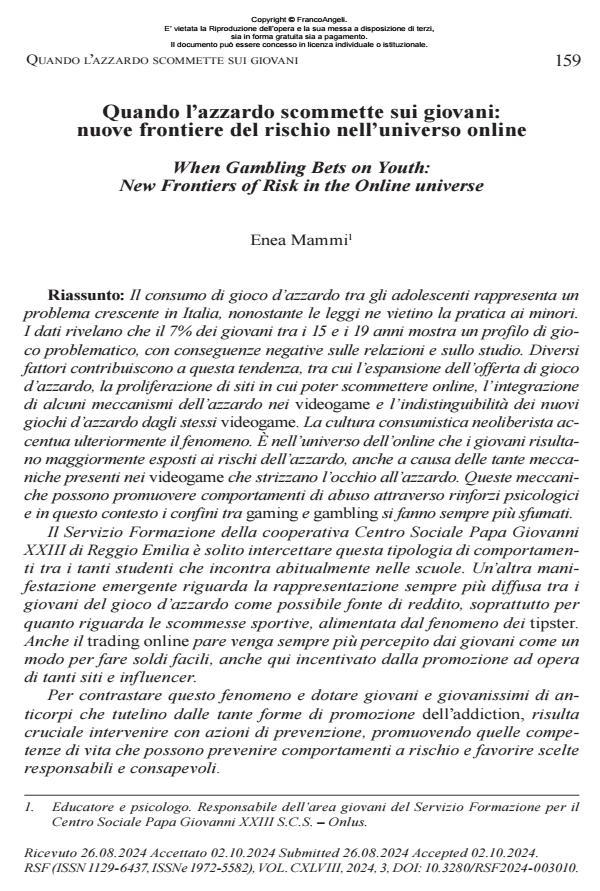When Gambling Bets on Youth: New Frontiers of Risk in the Online universe
Journal title RIVISTA SPERIMENTALE DI FRENIATRIA
Author/s Enea Mammi
Publishing Year 2024 Issue 2024/3
Language Italian Pages 12 P. 159-170 File size 719 KB
DOI 10.3280/RSF2024-003010
DOI is like a bar code for intellectual property: to have more infomation
click here
Below, you can see the article first page
If you want to buy this article in PDF format, you can do it, following the instructions to buy download credits

FrancoAngeli is member of Publishers International Linking Association, Inc (PILA), a not-for-profit association which run the CrossRef service enabling links to and from online scholarly content.
Gambling consumption among adolescents represents a growing problem in Italy, despite laws prohibiting the practice for minors. Data reveals that 7% of young people between 15 and 19 years old exhibit pro- blematic gambling behaviors, with negative consequences on relationships and studies. Several factors contribute to this trend, including the expansion of gambling offerings, the proliferation of online betting sites, the integration of some gambling mechanisms into video games, and the indistinguishability of new gambling games from video games themselves. Neoliberal consumer culture further accentuates the phenomenon. It is in the online universe that young people are most exposed to the risks of gambling, also due to the many mechanics present in video games that wink at gambling. These mechanics can promote abusive behaviors through psychological reinforcements, and in this context, the boundaries between gaming and gambling are becoming increasingly blurred. The Servizio Formazione of the cooperative Centro Sociale Papa Giovan- ni XXIII in Reggio Emilia regularly intercepts this type of behavior among the many students it meets regularly in schools. Another emerging manifestation is the increasingly widespread perception among young people of gambling as a possible source of income, especially concerning sports betting, fueled by the phenomenon of tipsters. Online trading also seems to be increasingly perceived by young people as a way to make easy money, again incentivized by the promotion by many sites and influencers. To combat this phenomenon and equip young people with the defenses needed to protect themselves from the many forms of addiction promotion, it is crucial to intervene with preventive actions, promoting life skills that can prevent risky behaviors and foster responsible and conscious choices.
Keywords: gambling, videogames, adolescents, online, prevention, life skills
Enea Mammi, Quando l’azzardo scommette sui giovani: nuove frontiere del rischio nell’universo online in "RIVISTA SPERIMENTALE DI FRENIATRIA" 3/2024, pp 159-170, DOI: 10.3280/RSF2024-003010